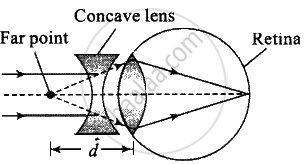Advertisements
Advertisements
Question
A myopic adult has a far point at 0.1 m. His power of accomodation is 4 diopters.
- What power lenses are required to see distant objects?
- What is his near point without glasses?
- What is his near point with glasses? (Take the image distance from the lens of the eye to the retina to be 2 cm.)
Solution
 (a) Defected eye |
 (b) Removal of Defect |
`1/f = 1/f_1 + 1/f_2`
In terms of power P = P1 + P2
i. If for the normal relaxed eye of an average person, the power at the far point be `P_f`. The required power
`P_f = 1/f = 1/0.1 + 1/0.2` = 60 D
By the corrective lens the object distance at the far point is `oo`
The power required is `P_f^' = 1/f^' = 1/(oo) + 1/0.02` = 50 D
Now for eye + lens system, we have the sum of the eye and that of the glasses `P_g`
`P_f^' = P_f + P_g` ⇒ 50 D = 60 D + `P_g`
Which gives, `P_g` = – 10 D
ii. For the normal eye his power of accommodation is 4 D, Let the power of the normal eye for near vision be `P_n`.
Then, 4 = `P_n = P_f` or `P_n` = 64 D
Let his near point be `x_n`, then
`1/x_n + 1/0.02` = 64 to `1/x_n + 50` = 64
`1/x_n` = 14 ⇒ `x_n = 1/14 m` = 0.07 m
iii. With glasses `P_n^' = P_f^' + 4` = 54
54 = `1/x_n^' + 1/0.02 = 1/x_n^' + 50`
`1/x_n` = 14 ⇒ `x_n^' = 1/4 m` = 0.25 m
APPEARS IN
RELATED QUESTIONS
A myopic person has been using spectacles of power −1.0 dioptre for distant vision. During old age, he also needs to use the separate reading glass of power + 2.0 dioptres. Explain what may have happened.
A person looking at a person wearing a shirt with a pattern comprising vertical and horizontal lines is able to see the vertical lines more distinctly than the horizontal ones. What is this defect due to? How is such a defect of vision corrected?
In viewing through a magnifying glass, one usually positions one’s eyes very close to the lens. Does angular magnification change if the eye is moved back?
The muscles of a normal eye are least strained when the eye is focussed on an object
A person A can clearly see objects between 25 cm and 200 cm. Which of the following may represent the range of clear vision for a person B having muscles stronger than A, but all other parameters of eye identical to that of A?
The focal length of a normal eye-lens is about
When we see an object, the image formed on the retina is
(a) real
(b) virtual
(c) erect
(d) inverted
Mark the correct options.
(a) If the far point goes ahead, the power of the divergent lens should be reduced.
(b) If the near point goes ahead, the power of the convergent lens should be reduced.
(c) If the far point is 1 m away from the eye, divergent lens should be used.
(d) If the near point is 1 m away from the eye, divergent lens should be used.
A person looks at different trees in an open space with the following details. Arrange the trees in decreasing order of their apparent sizes.
| Tree | Height(m) | Distance from the eye(m) |
| A | 2.0 | 50 |
| B | 2.5 | 80 |
| C | 1.8 | 70 |
| D | 2.8 | 100 |
A normal eye has retina 2 cm behind the eye-lens. What is the power of the eye-lens when the eye is (a) fully relaxed, (b) most strained?
